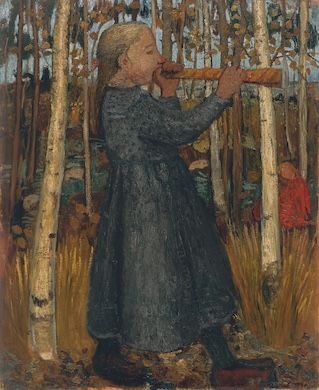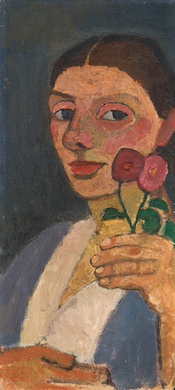‘Paula Modersohn-Becker: Ich Bin Ich/I Am Me’
The Neue Galerie
Until September 9
“Paula Modersohn-Becker’s focus on issues of identity makes her work particularly resonant in our own time”: So begins an essay in the catalog accompanying an exhibition, “Paula Modersohn-Becker: Ich Bin Ich/I Am Me.” The curator, Jill Lloyd, a specialist in German modernism, has organized some arresting exhibitions at the Neue Galerie, not least the canon-expanding show dedicated to a troubled Austrian painter, Richard Gerstl.
Will “Ich Bin Ich” do the same for Modersohn-Becker (1876-1907)? Impassioned art mavens might argue that she already is in the canon. Although largely unknown at the time of her death, Modersohn-Becker’s reputation gained traction upon the subsequent mounting of important shows and the publication of her letters and journals. Two decades after her death, a coffee magnate and art collector, Ludwig Roselius, saw to the construction of the first institution dedicated exclusively to a woman artist, the Paula Modersohn-Becker Museum at Bremen, Germany.
Still and all, general audiences can be forgiven for asking: “Paula who?” Although the work has been seen in the States on a piecemeal basis, the Neue Galerie show, which has been mounted in conjunction with the Art Institute of Chicago, is the first American museum retrospective dedicated to Modersohn-Becker’s paintings, drawings, and prints. The president of the venerable 86th Street institution, Ronald Lauder, writes that the artist “deserves to be better known.” “Ich Bin Ich” is an event.
Among the reasons that Modersohn-Becker doesn’t have the renown of Kathe Kollwitz, currently the subject of a stellar exhibition at the Museum of Modern Art, is her untimely death. Modersohn-Becker grew up in Dresden under privileged circumstances — her father was an engineer, her mother the scion of aristocrats — but the family suffered ostracization, particularly after Uncle Oskar attempted to assassinate King Wihelm of Prussia. That kind of thing doesn’t endear one’s family to the community. The family moved to Dresden.

Via Paula Modersohn-Becker Museum, Bremen, Germany
Modersohn-Becker took an interest in drawing at a young age and later studied art in England. The family wished her to become a teacher. Modersohn-Becker took another path: pursuing further artistic studies at Berlin, Paris, and Worpswede, a north German town that was home to a colony of painters frustrated with the academy. It was there that she met an established painter who would become her husband, Otto Modersohn, and the poet Rainer Maria Wilke — two men who would have a decisive impact on her art and her life.
“Ich Bin Ich” begins with a gallery devoted to Modersohn-Becker’s early figure drawings. Done largely in charcoal, they are sizable in scale and prole in their leanings. When delineating the human form, Modersohn-Becker was less interested in classical ideals than subjects found down the road. If the title of a specific piece doesn’t clue us in to the occupation of the sitter, their humble and sometimes homely attributes do. These are remarkably assured drawings, tending slightly to caricature but deft in touch and surface. Comparisons to Daumier and Millet are warranted.
Her efforts with oils are another animal altogether. Paint, in Modersohn-Becker’s hands, is an ungainly and resistant material, more a medium for texture than color or light. The pictures of children, still-lifes, and herself are intensive but crabbed in affect, and almost discomfitingly narrow. The palette is, on the whole, bereft of vibrancy, and the compositions ill-fitted. The landscapes, especially, don’t distinguish between Expressionist ardor and pictorial irresolution.

Via the Neue Galerie and the Museum of Modern Art
There are fine pictures at the Neue Galerie — “Sleeping Child” (circa 1904), “Old Woman from the Poorhouse Sitting in the Garden” (circa 1905), and the totemic “Reclining Mother with Child II” (1906) — but when Ms. Lloyd compares Modersohn-Becker’s hard-scrabble imagery to that of Alberto Giacometti, she’s engaging in special pleading for a talent whose lifespan was “brutally cut short.”
Dead at age 31 from complications due to childbirth, Modersohn-Becker’s achievement was, of necessity, stunted. Still, the sum of the parts included in “Ich Bin Ich” earns our recognition even as it underlines the inequities of fate and art.




